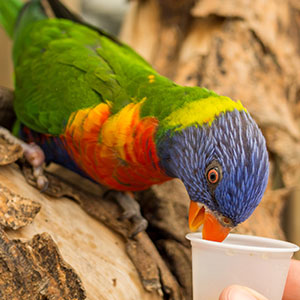
Why Lactobacillus is Important to Your Bird's Health
By Cheryl Lake
Lactobacillus acidophilus is a source of a viable live, naturally occurring micro-organism, which is found predominant in the digestive system of man and all warm blooded animals. Stress conditions such as new arrivals, molting, breeding, feeding young, growth, preparation for flight, illness and injury, along with contaminated feed and water, food soured in the crop, chlorinated water, antifungal and antibiotic therapy, can all cause a great imbalance of various types of micro-organisms in the crop and intestine tract, leaving birds susceptible to digestive problems.A bird's death may result from organ failure, not caused by the initial microbial imbalance, but from the secondary invasion of a disease causing micro-organism through the intestinal barrier. Once a pathogenic organism penetrates the intestinal barrier, an antifungal or antibiotic is most likely a necessity to improve the animal's condition.
Numerous factors influence the interactions among intestinal micro-organisms and their hosts. The cumulative effect of these interactions control the composition and metabolic activity of this gut microflora. An optimal "balance" in microbial population has been associated with good health. There is evidence indicating that certain micro-organisms, particularly the lactobacilli, can help maintain such favorable microbial profile in the gut either through being pat of the natural microflora or as a dietary supplement. As a part of the natural flora, they can exert healthful effects through antibiotic and organic acid production, lowering of pH and oxidation potential, competitive antagonism, and bile deconjugation. As a dietary supplement, they have a positive impact on growth, are functional in preventive and curative treatments as well as being sources of certain enzymes essential for metabolism of some nutrients.
There generally exist two kinds of microbial flora in the digestive tract. The first consists of indigenous, beneficial micro-organisms which have achieved a close relationship with the host through a long period of evolution. The other consists of potentially pathogenic micro-organisms.
The major role of this microflora is to aid digestion of food. For efficient digestion and maximum absorption of nutrients it is essential that a balance of micro-organisms be maintained. However, in this day and age, maintaining a normal healthy intestinal tract is difficult. Animals are often subjected to stress conditions. Under these circumstances the pathogenic bacteria may predominate bacterial overgrowth, and create an "imbalance" which in turn may impair normal gut function and lead to various problems ranging from inefficient digestion and utilization of feed enteritis. Studies indicate that lactobacilli are the bacteria most affected by stress. This results in a reduction of the tract. When this occurs, the beneficial effect of lactobacilli in maintaining a proper pH and microflora is lost. Alteration in the micro flora by such imbalance coincides with onset of vomiting, diarrhea, or other gastroenteritis infections.
More specifically, the significance of selected lactobacilli to intestinal well-being, the defense of the host, and in the interruptions of certain disease is now well documented. Lactobacilli have been employed in preventing overgrowth by antibiotics resistant species of Candida, Pseudomonas, Staphylococcus, and E. coli during antibiotic therapy, when the normal micro flora is suppressed because of stress functions or by antibiotics. Another consequence of bacterial overgrowth of the small intestine is the formulation of a variety of protein end-product which are no longer of use by the host. That is, the proteins normally available to the host are so changed by the intestinal flora that they can no longer be utilized. Such detrimental effects of this microbial imbalance can in many instances be prevented by supplementing the intestinal tract with a functional level of lactobacilli.
The probiotic concept is defined as the concept of increasing the beneficial micro-organisms in the digestive tract of the host animal by introducing large numbers of desirable bacteria to reestablish and maintain an ideal situation in the gut. There have not been any reports of pathogenicity, and there are no known side effects, withdrawals, or problems from excessive dosages. Strains of Lactobacillus acidophilus and other lactic bacteria have been found to possess marked inhibitory properties against intestinal pathogens as well as food spoilage organisms. Selective inhibition has been attributed in part to the ability of lactic acid organisms to produce natural antibiotics. Lactobacillus acidophilus specifically has been reported as producing antibiotics, notably acidophillin, lactolin and acidolin.
The acidolin production together with the lactic acid production is responsible for the excellent anti- microbial activity against enterpathogenic organisms including E.coli, Klebsiella pheumoniae, Salmonella typhimurium, Staphylococcus aureus, Clostridium perfringens, Pseudomonas aeruginosa (green diarrhea), Shigella paradysenteriae (New Castle), and against spore formers. Futher, it is active against polio virus (type 1). Inhibition of pathogens by lactobacilli also is attributed to their alteration of pH through acid production. Because of their extensive fermentive capacity, lactic acid bacteria produce significant amounts of metabolic products including acetic, formic, and lactic acids, the inhibiting properties of which are well recognized.
Lactobacilli changes the oxidation-reduction potential through its production of metabolites. By making the environment less conducive for organisms requiring oxygen this action of the lactobacilli contributes to the overall inhibiting effect of these bacteria.
Another means by which lactobacilli may retard growth of other micro-organisms is through nutrient depletion (competitive antagonism). Differences in metabolic activities make it possible for an organism to exhaust an essential nutrient from a growth medium and thus inhibit growth of other bacteria. In this respect Lactobacillus acidophilus is very effective. Implantation or adherence to the epithelial cells of the gut (villi) is of central importance for the function of a probiotic.
The chicken is a unique experimental animal in which to examine the phenomenon of implantation. Its crop characteristically contains a microflora in which the lactobacilli predominate over coliforms and streptococci. This population of lactobacilli is in a position to influence not only the microflora of the crop, but also that of the small intestine. That is the reason why chickens have been used as the biological test system for the study of the implantation of bacteria in the intestines. It is believed, however, that the phenomenon of implantation has a general application to other species.
It has been suggested that the adhesion to crop epithelium allows large numbers of lactobacilli to remain behind after the food moves on, and thus it provides a continuous inoculum for incoming, freshly ingested food. Thus a vigorous lactobacillus fermentation is maintained in the crop producing a low pH which is harmful to the growth of most other bacteria. The present results confirm that ability to adhere to the epithelium is a distinct advantage in the implantation of the crop by lactobacilli.
An interesting experiment was conducted with 360 broad-breasted, large white turkey poults to study the effect of application of Lactobacillus acidophilus in drinking water from 0-20 weeks. The average weight of the treated birds at the end of the experiment was 1.6 lbs. per bird greater than control birds. Birds in treated groups consumed 2.577 lb. more feed per bird on an average when compared with controls during the 20 weeks.
ANTEMORTEM FINDINGS: Treated birds appeared distinctly healthier than controls. The treated birds had white, glossy feathers that were more smoothly distributed over their bodies than the off colored feathers of the control birds. The carcasses of the treated group were distinctly larger, and the color of skin was white. The carcasses of the control groups had yellowish discoloration and were smaller.
POST-MORTEM FINDINGS: The birds were slaughtered commercially, and 20% of the livers, intestines, and fat pads were randomly collected from both groups for their physical comparisons. The carcasses were also compared physically.
It was observed that livers from the treated group were darker, more solid and a little smaller in size than livers from the control group of which were large, soft and discolored. Such signs were not observed on the livers of the treated group. Intestines from the control group were heavier, congested and thicker.
The color and consistency of the fat pads were also different in the treated versus control birds. The treated group had white fat pads that were more solid in consistency, while the control group had yellow fat pads that were soft in consistency. It appears from this observation that the lactobacillus organism has helped the bird to utilize carotene pigment more efficiently. In general, the treated birds were more active.
The condition of the liver and intestines in the control group where the birds were apparently healthy may indicate the birds experienced biological stress and low grade infective process.
The above findings-i.e., dark healthy livers, less congestion and thinner intestinal walls, and white fat pads having solid consistency can be attributed as a response to Lactobacillus acidophilus application, the net result being larger carcasses.
A functional level of lactobacilli must be supplied, i.e. the concentration of viable cells must be significant. Research has shown that while lactobacilli attach to the epithelial cells in the intestine tract, they do not colonize. In other words, lactobacilli implant and grow, forming an outer coating on the villi. But this coating will eventually slough off as the food bolus moves through the intestines. Contrary to this, many disease-causing organisms form colonies of bacteria that actually penetrate the villi and are not sloughed off as easily. Therefore, to compete with these organisms, lactobacilli must be administered regularly at a high dosage level. The method of application must be such that the animal received the viable organism at the functional level. This seems very obvious but is not fully recognized. Lactobacilli cannot survive pelletizing or be mixed into the feed for long periods of time prior to administering. Therefore, direct application methods, such as via the drinking water or as a top dressing are necessary.
Neglecting these criteria obviously has affected research work and the validity of the resulting data. There is no doubt that this circumstance is responsible for the limited usage and acknowledgment of probiotics in feeding animals or as a dietary supplement for humans. But with today's knowledge and technology this obstacle should be overcome.
For the first day of life on a healthy chick, we feed only nonchlorinated water and add Lactobacillus until it resembles skim milk. Depending on the age and size of the baby birds we add 1/4 teaspoon per day for 1-2 macaw chicks, or approximately the same 1/4 teaspoon for 2-4 babies of the smaller species. If I see the first signs of a slow moving crop, or if any leftover food residue remains, treating immediately with Lactobacillus acidophilus will generally correct the balance in the crop and eliminate the need for antibiotics. I will first let all the food pass through, or flush out the crop to avoid the possibility of creating an imbalanced incubation chamber of potentially disease causing organism. I then feed a bland, easily digested diet to which I add 2-4 times the normal amount of Lactobacillus acidophilus.
The process involved behind these observed benefits of feeding Lactobacillus acidophilus requires further studies. There are many other unanswered questions regarding techniques and environmental stress conditions that need to be investigated. Further studies with these and other strains of Lactobacillus acidophilus are cetainly warranted. The potential of such products seem unlimited.
Discover More!
Pet Bird NutritionBird Feather Health and Anatomy
Return to Bird Articles


